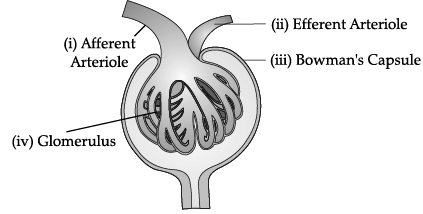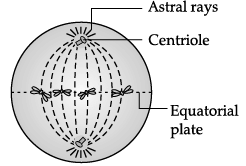Class 11 Biology: CBSE Sample Question Papers- Term II (2021-22)- 1 | Sample Papers for Class 11 Medical and Non-Medical - JEE PDF Download
| Table of contents |

|
| Class Xl |

|
| Time: 120 Minutes |

|
| Max. Marks: 35 |

|
| Section - A |

|
| Section - B |

|
| Section - C |

|
Class Xl
Time: 120 Minutes
Max. Marks: 35
General Instructions:
- All questions are compulsory.
- The question paper has three sections of 13 questions. All questions are compulsory.
- Section–A has 6 questions of 2 marks each; Section–B has 6 questions of 3 marks each; and Section–C has a case-based question of 5 marks.
- There is no overall choice. However, internal choices have been provided in some questions. A student has to attempt only one of the alternatives in such questions.
- Wherever necessary, neat and properly labelled diagrams should be drawn.
Section - A
Q.1. RuBisCO is an enzyme that acts both as a carboxylase and oxygenase.
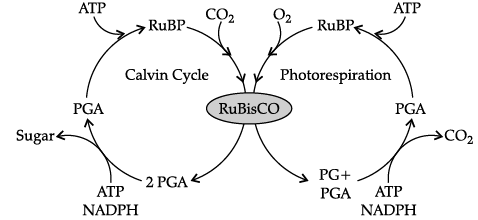
Study the above diagram carefully and explain why RuBisCO carries out more carboxylation in C4 plants?
RuBisCO carries out more carboxylation in C4 plants because these plants have mechanism that increases the concentration of CO2 at the enzymatic site. During the C4 pathway, when the C4 acid from the mesophyll cells is broken down in the bundle sheath cells, it releases CO2. This results in the increased intracellular concentration of CO2. So, RuBisCO functions as the carboxylase and binds with plants and carry out more carboxylation.
Q.2. What is glycolysis ? Where does it occur?
Glycolysis is also called as EMP (Embden Meyerhof Parnas) pathway. Glycolysis is the process of breakdown of glucose or similar hexose sugar to two molecules of Pyruvic acid through a series of enzyme mediated reactions releasing some energy (ATP) and reducing power (NADH). It occurs is cytosol or cytoplasm.
OR
Anaerobic respiration works in contrast to the highly efficient process of aerobic respiration, which relies on oxygen to produce energy. Anaerobic respiration cannot continue for a long in higher organisms. Why ? Give any two reasons.
Anaerobic respiration cannot continue for a long in higher organisms because of:
(i) Low yield of energy.
(ii) Decomposition of large amount of substrates, so that little is left for growth and repairs.
(iii) Toxic effect of end products in higher concentration.
(iv) Inhibition of a number of physiological processes linked with aerobic respiration.
Q.3. Given below is the diagram showing different parts of a stem.
In most of the plants, the terminal bud suppresses the development of lateral buds.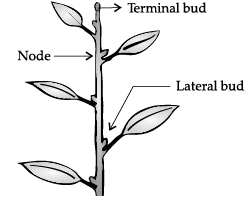
(i) What is this phenomenon called?
(ii) Name the phytohormone that can promote the phenomenon.
(i) This phenomenon is called Apical dominance.
(ii) Auxins are the phytohormones which can promote this phenomenon in plants. e.g., NAA and 2, 4-D, etc.
Q.4. The diagram below shows an ECG of a normal human being.

If a patient’s ECG revealed an abnormally long delay between the P wave and the QRS deflection, what would that suggest?
If a patient’s ECG revealed an abnormally long delay between P wave and the QRS deflection, it suggests that there is a delay of conduction from the atria to the ventricles, hence the stimulation from SA nodes are conducting stimuli very slowly to the ventricles.
Q.5. Label the parts in the following diagram using the terms given below:
(i) Afferent arteriole
(ii) Efferent arteriole
(iii) Bowman‘s capsule
(iv) Glomerulus
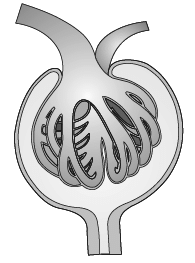
Q.6. LH is secreted by Adenohypophysis or anterior pituitary gland.
(i) Mention the other hormone along with which it acts on its target cells/ organ.
(ii) Give two functions of each hormone.
(i) FSH is the other hormone (gonadotropin) along with which it acts on its target cells/organ.
(ii) Functions of LH:
- In males, it stimulates spermatogenesis.
- In females, it stimulates ovulation and formation of the corpus luteum.
Functions of FSH :
- In females, it stimulates the growth of ovarian follicles.
- It regulates the growth and development of secondary sexual characters and other reproductive processes.
OR
Study the given diagram.
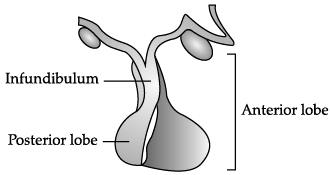
Why is the above gland referred to as the ‘Master gland’?
(i) The given diagram is of pituitary gland. The pituitary is called “Master Endocrine Gland” because of the number of hormones it produces and the control it exercises over the other endocrine glands.
(ii) It itself is under the control of the releasing-hormones secreted by the hypothalamus of the brain. Thus, there is a chain of orders : the hypothalamus directs the pituitary output, which controls the secretion of hormones by other endocrine glands.
Section - B
Q.7. Auxins are the growth hormones capable of promoting cell elongation. They have been used in horticulture to promote growth, flowering and rooting. Write a line to explain the meaning of the following terms related to auxins.
(i) Auxins precursors
(ii) Anti-auxins
(iii) Synthetic auxins
(i) Auxin precursors: These are the raw materials used in synthesis of auxins. For example, tryptophan is an Indole-3- acetic acid.
(ii) Anti-auxins: T hese are the compounds which inhibit the action of auxin. For example, TIBA acts as anti-auxins by blocking transport of auxin.
(iii) Synthetic auxin: Auxins which are manufactured synthetically and do not grow naturally in plants. E.g. 2,4-D, NAA, etc.
OR
By looking at which internal structure of a plant you can tell whether a plant is C3 or C4? Explain.
By seeing the V. S. of leaves, one of C3 plant and the other of a C4 plant.
(i) The C4 plant leaves have Kranz anatomy. The chloroplasts in C4 leaves are dimorphic.
(ii) The bundle sheath cells in C4 make several layers around the vascular bundles. The C3 plants do not have bundle sheath.
(iii) C4 leaves possess large number of chloroplasts, thick cell wall impervious to gaseous exchange and there are no intercellular spaces e.g., maize and Sorghum leaves. The C3 plants possess one type of chloroplasts.
Q.8. Japanese farmers in their rice field observed that certain rice seedlings grow excessively tall and become weak and sterile. One of the Japanese plant pathologists found that, it is due to some disease, which is caused by a fungus. He named this disease as “bakane” or “foolish seedling” disease. Yabuta extracted the active substance i.e., growth promoting substances and termed them as gibberellin.
(i) Name the fungus, which caused “bakane” or “foolish seedling” disease.
(ii) Give three functions of ‘Gibberellin’.
(i) Gibberella fujikuroi is the fungus which causes ‘Bakane’ or foolish-seedling disease. Gibberellin, a plant hormone was discovered from the same fungus.
(ii) The functions of Gibberellins are:
- Bolting and flowering.
- Stem elongation and fruit ripening.
- Parthenocarpy.
- Early seed production.
OR
“X” is also called as stress hormone because its synthesis is stimulated by drought, water logging and other adverse environmental conditions. It is produced in many parts of the plants but more abundantly inside the chloroplast of green cells.
(i) Identify “X”.
(ii) Mention any two functions of this hormone.
(iii) How are they antagonistic to gibberellins?
(i) The hormone “X” is Abscisic acid.
(ii) Functions of Abscisic acid:
- Abscisic acid owes its name to its role in the abscission of plant leaves. In preparation for winter, ABA is produced in terminal buds. This slows plant growth and directs leaf primordia to develop scales to protect the dormant buds during the cold season.
- It plays an important role in seed development and maturation.
(iii) They are antagonistic to gibberellins as gibberellin promotes stem elongation while abscisic acid acts as plant growth inhibitor.
Q.9. The diagram given below represents a section of human heart.
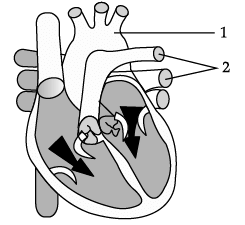
(i) Which parts of the heart are in the diastolic phase? Give a reason to support your answer.
(ii) Label the parts numbered 1 and 2 in the diagram. What type of blood flows through them.
(iii) What causes the heart sounds ‘LUBB’ and ‘DUBB’.
(i) Ventricles
As Tricuspid and bicuspid valves are open / Semilunar valves are closed.
(ii) 1 – Pulmonary artery, deoxygenated blood.
2 – Pulmonary veins, oxygenated blood.
(iii) LUBB – Closure of tricuspid and bicuspid valves.
DUBB – Closure of semilunar valves.
Q.10. The following diagram represents the human heart in one phase of its activity.

(i) Name the phase.
(ii) Which parts of the heart are contracting in this phase?
(iii) How many valves are closed in this phase?
(i) The phase shown in the figure is ventricular systole.
(ii) The lower part consisting of the right and left ventricles are contracting in this phase as the blood seems to be flowing into the pulmonary artery and main aorta, while the bicuspid and tricuspid valves are closed.
(iii) Two valves i.e., the bicuspid and tricuspid valves leading from the atria to the ventricles are closed during systole to prevent the back-flow of blood into the atria.
Q.11. During muscle contraction, a neural signal, released by central nervous system, when reaches the neuromuscular junction, it releases a neurotransmitter (Acetylcholine) which generates an action potential in the sarcolemma. This action potential along the length spreads through the muscle fibre and causes the release of calcium ions into the sarcoplasm.
(i) Describe the significance of Ca2+ ions in the contraction of muscles.
(ii) Which neurotransmitter is responsible for contraction of muscle?
(i) Calcium plays a key role in the muscle contraction process. During contraction of muscles, from the motor end plate, an action potential passes over the sarcolemma and further into the T-tubules and sarcoplasmic reticulum and triggers it to produce Ca2+ ions into the sarcoplasm. The binding of calcium ions to the troponin causes its shape and position to change which in turn modifies position and shape of tropomyosin that binds the troponin. This shift presents the active sites on the molecule, F-actin which prompts the myosin cross-bridges to bind to these active sites.
(ii) Acetylcholine is the neurotransmitter that is responsible for contraction of muscle.
Q.12. A patient was complaining of frequent urination, excessive thirst, hunger and tiredness. His fasting blood was found higher than 130 mg/dL on two occasions.
(i) Name the disease.
(ii) Give the root cause of this disease.
(iii) Explain why the blood glucose level is higher than 130 mg/dL.
(i) The disease is Diabetes mellitus.
(ii) The failure of the b-cells of the islets of langerhans of pancreas to produce adequate amount of insulin, is the root cause of this disease.
(iii) It was due to the undersecretion of insulin hormone. The undersecretion of insulin impairs the following functions:
- Utilisation and uptake of glucose by adipocytes and hepatocytes.
- Conversion of glucose into glycogen by the above target cells.
Section - C
Q.13. Cell division is the process in which division of nucleus and cytoplasms, occurs. The diagram below represents a stage during the cell division. Study the same and then answer the questions than follow:
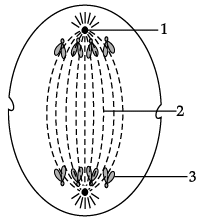
(i) Name the parts labelled 1, 2 and 3.
(ii) Identify the above stage and give a reason to support your answer.
(iii) Mention where in the body this type of cell division occurs.
(iv) Name the stage prior to this stage and draw a diagram to represent the same.
(i)
1 - Centrioles.
2 - Spindle fibres3 – Chromatids
(ii) The stage described in the diagram is the late anaphase of mitosis in an animal cell. The stage can be identified by the presence of separated chromatids which are found at the two poles of the cell. The appearance of the furrow in the cell membrane classifies the stage as the late anaphase.
(iii) The division shown in the diagram is mitotic division and this kind of cell division occurs in all the cells of the body except for the reproductive cells.
(iv) The stage before anaphase is metaphase.
OR
Meiosis is the process in which a single cell divides twice to form four haploid daughter cells. The process is split into meiosis I and meiosis II, and both meiotic divisions have multiple phases. Meiosis I is a type of cell division unique to germ cells, while meiosis II is similar to mitosis. The diagram given below represents a certain phenomenon which occurs during meiosis.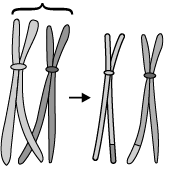
- Name the above phenomenon.
- Explain it with reference to homologous chromosomes, chromatids, and crossing-over.
(i) The given phenomenon is the exchange of chromatids between homologous chromosomes called crossing-over. This is the process by which the two chromosomes of a homologous pair exchange equal segments with each other.
(ii) Crossing over occurs in the first division of meiosis. At that stage, each chromosome has replicated into two strands called sister chromatids. The two homologous chromosomes of a pair, synapse or come together. While the chromosomes are synapsed, breaks occur at corresponding points in two of the non-sister chromatids, i.e., in one chromatid of each chromosome.
Since the chromosomes are homologous, breaks at corresponding points, means that the segments that are broken off contain corresponding genes, i.e., alleles. The broken sections are then exchanged between the chromosomes to form complete new units, and each new recombined chromosome of the pair can go to a different daughter sex cell. It results in recombination of genes found on the same chromosome, called linked genes that would otherwise always be transmitted together.

